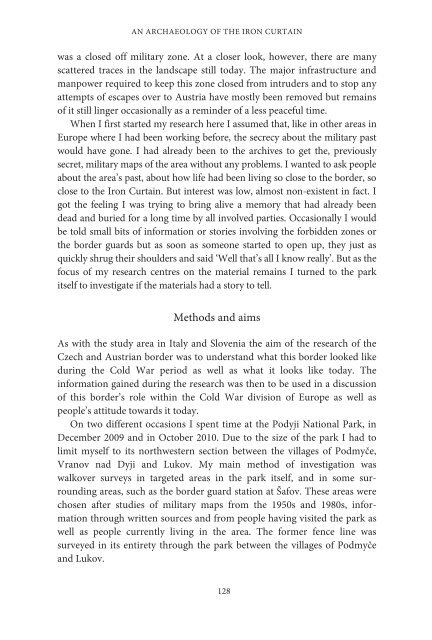1JZGauQ
1JZGauQ
1JZGauQ
You also want an ePaper? Increase the reach of your titles
YUMPU automatically turns print PDFs into web optimized ePapers that Google loves.
AN ARCHAEOLOGY OF THE IRON CURTAIN<br />
was a closed off military zone. At a closer look, however, there are many<br />
scattered traces in the landscape still today. The major infrastructure and<br />
manpower required to keep this zone closed from intruders and to stop any<br />
attempts of escapes over to Austria have mostly been removed but remains<br />
of it still linger occasionally as a reminder of a less peaceful time.<br />
When I first started my research here I assumed that, like in other areas in<br />
Europe where I had been working before, the secrecy about the military past<br />
would have gone. I had already been to the archives to get the, previously<br />
secret, military maps of the area without any problems. I wanted to ask people<br />
about the area’s past, about how life had been living so close to the border, so<br />
close to the Iron Curtain. But interest was low, almost non-existent in fact. I<br />
got the feeling I was trying to bring alive a memory that had already been<br />
dead and buried for a long time by all involved parties. Occasionally I would<br />
be told small bits of information or stories involving the forbidden zones or<br />
the border guards but as soon as someone started to open up, they just as<br />
quickly shrug their shoulders and said ‘Well that’s all I know really’. But as the<br />
focus of my research centres on the material remains I turned to the park<br />
itself to investigate if the materials had a story to tell.<br />
Methods and aims<br />
As with the study area in Italy and Slovenia the aim of the research of the<br />
Czech and Austrian border was to understand what this border looked like<br />
during the Cold War period as well as what it looks like today. The<br />
information gained during the research was then to be used in a discussion<br />
of this border’s role within the Cold War division of Europe as well as<br />
people’s attitude towards it today.<br />
On two different occasions I spent time at the Podyji National Park, in<br />
December 2009 and in October 2010. Due to the size of the park I had to<br />
limit myself to its northwestern section between the villages of Podmyče,<br />
Vranov nad Dyji and Lukov. My main method of investigation was<br />
walkover surveys in targeted areas in the park itself, and in some surrounding<br />
areas, such as the border guard station at Šafov. These areas were<br />
chosen after studies of military maps from the 1950s and 1980s, information<br />
through written sources and from people having visited the park as<br />
well as people currently living in the area. The former fence line was<br />
surveyed in its entirety through the park between the villages of Podmyče<br />
and Lukov.<br />
128




